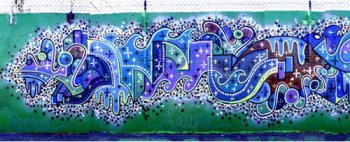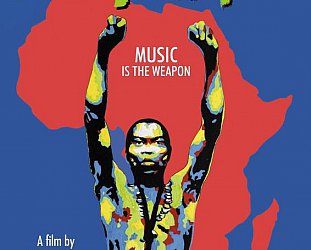Graham Reid | | 4 min read
Afrika Bambaataa: Planet Rock

It's just a guess, but I doubt Krost Krist, Anakea and Ryus know who Taki 183 or Papi 184 were.
That's a pity, because Taki 183 and Papi 184 started what Krost Krist and the others are doing down the railway which heads from Auckland city to Waitakere.
It is believed Taki 183 was the first -- but whether you think that's a good thing or not depends on what you think of graffiti. Or bombing, writing, vandalism, or whatever you want to call it.
Taki 183 was the New York City kid who started signing his stylised signature on subway cars and trains back in the late 70s. He lived in Washington Heights and his aim, as with many other NYC graffiti writers, was to go "all city".
It means to have your name on trains going all over town, so you could go down to any subway and see your name flashing by.
Then you'd know you'd made it. Were famous. Were known.
And when you were just another kid in a bleak suburb, to be known, famous even, was making it.
It sounds strange, pathetic even, to people who live validated lives or work jobs where they are respected. But signing a subway carriage - or better, creating a huge piece of art along its entire exterior - is underlined by the same principle that makes black American mothers give their daughters names like Chantelleyze or Mirandelle. In a world of "just another kid", theirs will stand out. Or make it.
Taki 183, Seen, Blade, Daze, Min One and many others graffiti writers and bombers made it. But as much through a 1983 doco as by going all city.
Style
Wars, directed by Tony Silver, did for graffiti art what Easy Rider did for
motorbikes. It turned the cameras onto the graffiti art of New York City subways
- and kids all over the planet could look at the colourful work of Duster, Iz
the Wiz and Mare139 on carriages which took their art and names all
city.
Style Wars was a revolutionary film documenting the upstart movement of hip-hop. It made the connection between the art sprayed on trains, the breakdancing of the Rock Steady Crew, and the rap of Grandmaster Flash and the Furious Five. Something was happening in the 'burbs of the Big Apple on the cusp of the 70s and 80s, and Silver and photographer Henry Chalfant captured it in 70 minutes of vibrant footage.
The film included interviews with the kids doing the work, followed them down the subways and filmed them as they created masterpieces or monstrosities. But it also gave time to the transit police trying to prevent the spread of graffiti, had amusing interviews with then-mayor Ed Koch who considered graffiti a quality of life offence, and civilians spoke up who felt the proliferation of graffiti was a sign the city had lost control.
But mostly it's the artists and their motivations which are under the spotlight. Seen - whose huge signature appeared on trains in various arresting styles like bubble cartoons, bamboo and 3D - mumbles like Robert DeNiro in Mean Streets, Cap is an outright anarchist vandal who wilfully scrawls his bloated signature across all other artists' work, and other writers proudly show the elaborate designs they spend hours working out before blowing them up large to cover the side of a freshly cleaned carriage.
And you cannot help but admire the technical skill, stylised designs and the sheer courage it takes to hang between two subway carriages at midnight creating something which might be wiped off in days.
As one writer says, doing this taught him how
to design, colour and create depth, and he learned photography so he could keep
a record of his pieces. He now applies those skills to his work on canvas which
end up in hip galleries.
Style Wars also hinted at that high art future in a segment at a fashionable downtown art gallery where graffiti writers are being claimed as the new primitives and their work on canvas is being sold for vastly inflated sums. It was the 80s of course and one patron observes, "If you get in the bottom of anything that's got to be a good investment".
The daubs of Jean-Michel Basquiat and career of Keith Haring were just around the corner.
The kids from Fame, and boxers Hector Comacho and Alex "The Bronx Bomber" Ramos appear in anti-graffiti ads telling the writers and bombers to "make your mark in society, not on society". But their best efforts and those of the transit police didn't work. Names went all city and, through the film, the arts went global.
Style War was a remarkable film for its time - and has now reappeared on DVD with hours of extra footage which add breadth and historical depth. There are contemporary interviews with some of the kids from the original, now in their late 30s/early 40s. Iz the Wiz who no longer bombs is asked what trains mean to him now: "A way from getting from point A to point B," he quips deadpan, then adds, "A way of getting your name from point A to point B."
Some of the former bombers are fat and have done time, others are artists, a few are dead, most are anonymous adults you'd pass on any Bronx or Brooklyn street on any day. Iz the Wiz, who creates another masterpiece for the camera, got sick in '95 from breathing in too many paint toxins and fumes from trains: "I'd trade it all," he says of the fame he achieved at the time, "for perfect health."
One former writer bemoans the quality of graffiti artists today. The sort of "better in my day" that you might hear from anyone on any topic.
Then there is the eccentric Rammallzee - worth the price of admission alone - who makes life-sized body suits out of dolls, plastic toys and junk, creates highly decorated art-pieces on skateboards and speaks a kind of Martian rap-poetry which makes no sense at all. He's either mad or a visionary.
 Style Wars might have been one of those documentaries
consigned to its period, but the new footage - much like watching Michael
Apted's Seven Up then skipping to 42 Up - makes it riveting all over again. More
than a documentary, it was a prescient piece of filming which encapsulated an
underworld gradually coming out into the light.
Style Wars might have been one of those documentaries
consigned to its period, but the new footage - much like watching Michael
Apted's Seven Up then skipping to 42 Up - makes it riveting all over again. More
than a documentary, it was a prescient piece of filming which encapsulated an
underworld gradually coming out into the light.
In the extra footage is previously unused footage where one of the cops in '82 worries if people around the world see this film that Silver is making then graffiti would just explode. Style Wars went global and screened on television in New Zealand in the early 80s.
Maybe the parents of Krost Krist, Anakea and Ryus videoed it?





post a comment